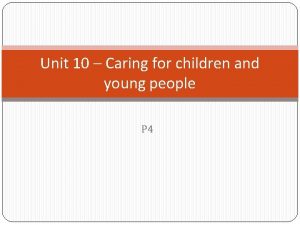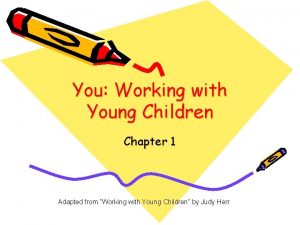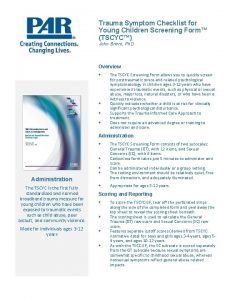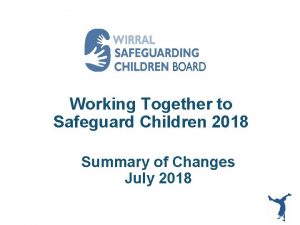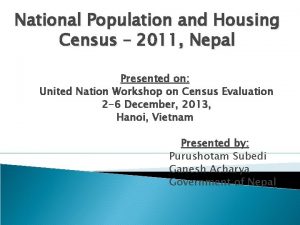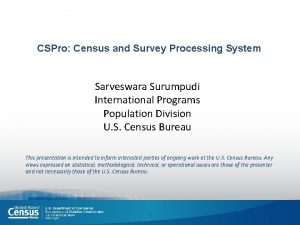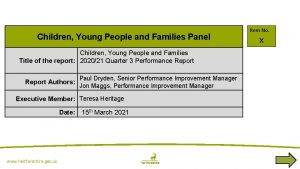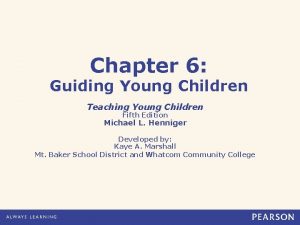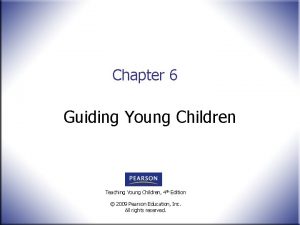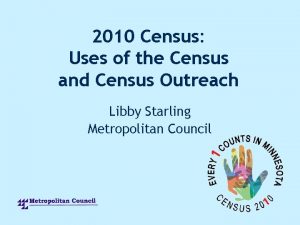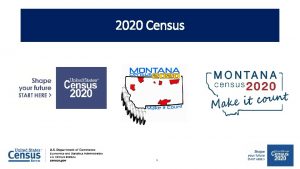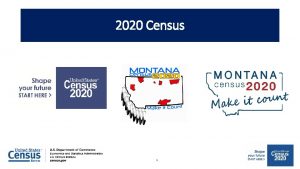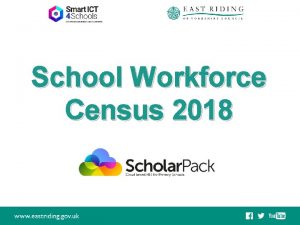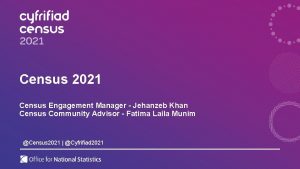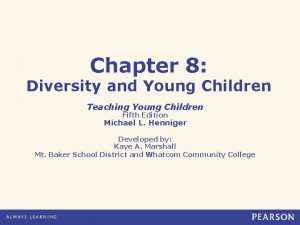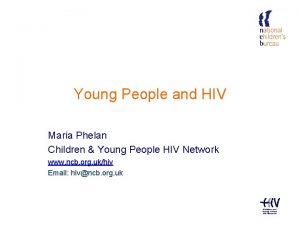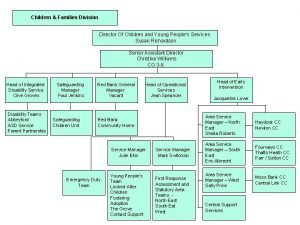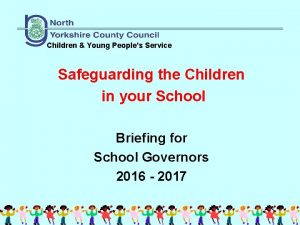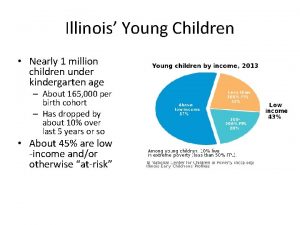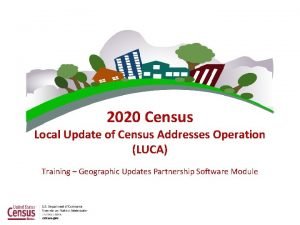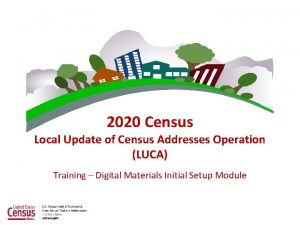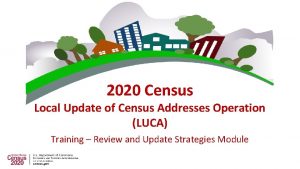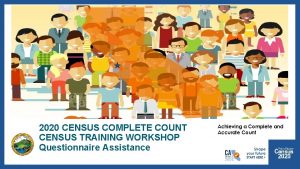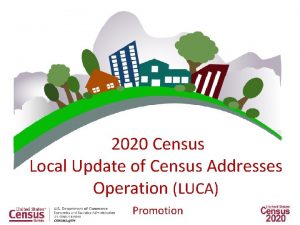Census 2020 Young Children and the Census Undercount



























- Slides: 27

Census 2020: Young Children and the Census Undercount A conversation with Funders June 5, 2019 www. ecfunders. org

Today’s Presenters Florencia Gutierrez Senior Research Associate Annie E. Casey Foundation Shannon Rudisill Executive Director Early Childhood Funders Collaborative Deborah Stein Network Director Partnership for America's Children Kiki Jamieson President The Fund for New Jersey

Census 2020: Young Children and the Census Undercount A Conversation with Funders about Contributing Factors and Actionable Solutions Deborah Stein Partnership for America’s Children www. foramericaschildren. org Dstein@foramericaschildren. org www. countallkids. org

In A Nutshell… • The number of young children missed in the Decennial census is large, growing, and the consequences are serious • Young children are missed for different reasons than adults; we need to count young children differently than we count adults • Advocates are working nationally, and in states and localities, to improve the count • Funders can play several roles in improving the count of young children and protecting their investments

Being Counted Helps Young Children Thrive • Stronger political representation: federal, state, county and School Board districts • More funding for key kids programs: more complete Census data can increase funding for some programs (Medicaid, CHIP, foster care, adoption, child care) • average in 37 states is $1200 lost per year per uncounted person • States lost over a half billion a year from the young child undercount from just five programs • More equitable distribution of funds: When total federal funding is capped, Census data often determines who gets it (Title 1, Special Ed, CCDBG, Head Start expansion funds) • Better planning: school size, health facilities, private enterprise • Better information for 10 years on child well being: Census data provides 10 of 16 indicators used in yearly KIDS COUNT report 5

Census Undercount of Young Children Is Large and Growing

One in 10 Young Children were Missed in the 2010 Census Net Undercounts and Omissions Population Numbers for Age 0 to 4 Net Undercounts and Omissions Rates for Age 0 to 4 2, 200, 000 970, 000 Net Undercount 10. 3% 4. 6% Omissions Net Undercount Omissions 7 Source: Hogan and Griffin 2016

Young Children Had a Higher Net Undercount (by far) Than Any Other Age Group in the 2010 Census Net Undercount Rate 3. 0 2. 6 2. 5 2. 0 1. 4 1. 3 0. 9 1. 0 2. 0 1. 8 1. 0 0. 0 -0. 3 -1. 0 -0. 1 -0. 7 -0. 2 -0. 1 -0. 3 -0. 5 -2. 0 -2. 2 -3. 0 -4. 0 -5. 0 -4. 6 0 -4 5 -9 10 -14 15 - 19 20 - 24 25 - 29 30 - 34 35 - 39 40 - 44 45 - 49 50 - 54 55 - 59 60 - 64 65 - 69 70 - 74 75 - 79 80 - 84 85+ Age Source: U. S. Census Bureau, May 2012 DA release 8

Since 1980, the Net Undercount of Young Children in the Census has Worsened While the Coverage of Adults has Improved 1 0 -1 1950 1960 1970 1980 1990 2000 Ages 0 -4 2010 Adults age 18+ Net Undercount Rate-2 -3 -4 -5 Source: O’Hare 2015, Chapter 4 9

Why Are Young Children Missed In The Census?

When Children are Missed: What We Know So Far • Four out of five children are missed because they are left off the roster • More likely to be missed if they live in complex households, particularly when the person filling out the form is not their parent • Fear and confusion about including young children • Children have hard to count characteristics such as living in a rental • Areas where kids are at high risk of being missed: • • Many children of color, Many linguistically isolated households, Many grandparent householders, or Many children not related to the householder

Efforts to Count All Kids Committee Count All Kids Campaign

Counting Young Children: What Works • Adults are usually missed because they don’t return the form • Census Bureau targets low response areas • Messaging around returning the form • Young children are usually missed when they are left off the form • • Developing maps showing where kids are often left off Conducting message research Developing outreach tools to persuade families to count children Working with Census Bureau to get them to conduct outreach around young children

Count All Kids Committee: National Complete Count Committee For Young Children • Working with the Census Bureau to improve their strategies and connect them with key partners • Coordinating national awareness efforts • Engaging national networks that work with families of young children

Count All Kids Campaign Supports state and local efforts to • Form Complete Count Committees, including priority on counting young children • Work with Complete Count Committees to build plans prioritizing young children, and use message tested outreach materials • Encourage providers to use our outreach materials with families with young children

Complete Count Committees Promote Census Participation

What Can Funders Do? • Florencia Gutierrez, Senior Associate, Annie E. Casey Foundation • Kiki Jamieson, President, The Fund for New Jersey

Children Under Age 5 At Greatest Risk for Undercount in New Jersey

Count All Kids Video (roll mouse to bottom of screen to show video controls, or click here to view online.

Resources • Count All Kids, www. countallkids. org (sign up for the campaign), on Facebook at Count All Kids, Twitter @Count. All. Kids • Fund for New Jersey, https: //fundfornj. org/census • Advocates for Children of New Jersey, https: //acnj. org/census 2020 nj/ • Annie E. Casey Foundation, https: //www. aecf. org/blog/2020 -census-each-decadewe-have-a-chance-to-get-it-right-and-countallkids/ • National Census advocacy campaign, www. censuscounts. org • Census Bureau resources on Complete Count Committees: https: //www. census. gov/programs-surveys/decennial-census/2020 census/complete_count. html • NCSL resources on Complete Count Committees: http: //www. ncsl. org/research/redistricting/2020 -census-resources-andlegislation. aspx

Supplemental Data on the Undercount of Young Children

2010 Census Net Undercount Rates for Children Age 0 to 4 by Race and Hispanic Origin Total Black Alone or in Combination Hispanic Proxy for Non. Hispanic White -2. 7 -4. 6 -6. 3 -7. 5 Source: U. S. Census Bureau, May 2012 DA Release 22

Net Undercount Rates* for Children Age 0 to 4 In the 2010 Census Were Higher in Larger Counties 5. 0 1. 3 0. 3 -1. 1 -1. 3 -2. 3 -4. 0 , 0 00 + 50 0 00 0, 0 25 , 0 00 -2 49 , -4 99 , 9 99 99 9 9 * Rate = Census counts minus Vintage 2010 population estimates 10 0 50 , 00 09 9, 99 00 04 20 , 10 , 00 01 9, 99 , 9 99 5, 00 0 -9 5, 00 0 an Th s Le s 9 -7. 8 Source: O'Hare 2017, International Journal of Social Science Studies 23

Family Structure: Two out of Three Children Missed Lived in Complex Households • Missed kids: • 16% lived in an address that wasn’t included in the census • 16% the only person missing in a housing unit that was “enumerated” (counted) • 68% missed along with some other members of a household • Much more likely to be missed when the person filling out the form isn’t their biological or adopted parent (but 73% of those missed were the child of the householder) • Complex households can be • Multi-generation households • Extended families • Multi-family households 24

Fear and Confusion • Some respondents may not want to report their child to the government • General distrust of government • 1. 8 million children age 0 -4 (6. 4 million age 0 to 17) are living with at least one undocumented parent and the addition of citizenship question may be a problem • Some young children are living with a grandparent in restricted housing unit • Some respondents think the Census Bureau does not want children included in the Census • 15 percent of people in a NALEO study said they would not include their young child or didn’t know if they would 25

Other Factors: Many Have Hard-To-Count Characteristics

Who Should be Engaged in Direct Outreach to Families • • • Schools Child care centers Faith communities Medical providers (including hospitals) Government agencies Services such as WIC Libraries Businesses ?
 Unit 10 caring for children and young people
Unit 10 caring for children and young people Working with young children/answer key chapter 1
Working with young children/answer key chapter 1 Tscyc screening form
Tscyc screening form Prephonemic stage
Prephonemic stage Hampshire services for young children
Hampshire services for young children Young children are particularly sensitive to ets
Young children are particularly sensitive to ets Working together to safeguard children 2018
Working together to safeguard children 2018 National population and housing census 2011
National population and housing census 2011 Cspro android
Cspro android Hát kết hợp bộ gõ cơ thể
Hát kết hợp bộ gõ cơ thể Slidetodoc
Slidetodoc Bổ thể
Bổ thể Tỉ lệ cơ thể trẻ em
Tỉ lệ cơ thể trẻ em Voi kéo gỗ như thế nào
Voi kéo gỗ như thế nào Chụp tư thế worms-breton
Chụp tư thế worms-breton Chúa yêu trần thế alleluia
Chúa yêu trần thế alleluia Các môn thể thao bắt đầu bằng từ đua
Các môn thể thao bắt đầu bằng từ đua Thế nào là hệ số cao nhất
Thế nào là hệ số cao nhất Các châu lục và đại dương trên thế giới
Các châu lục và đại dương trên thế giới Cong thức tính động năng
Cong thức tính động năng Trời xanh đây là của chúng ta thể thơ
Trời xanh đây là của chúng ta thể thơ Mật thư anh em như thể tay chân
Mật thư anh em như thể tay chân 101012 bằng
101012 bằng Phản ứng thế ankan
Phản ứng thế ankan Các châu lục và đại dương trên thế giới
Các châu lục và đại dương trên thế giới Thơ thất ngôn tứ tuyệt đường luật
Thơ thất ngôn tứ tuyệt đường luật Quá trình desamine hóa có thể tạo ra
Quá trình desamine hóa có thể tạo ra Một số thể thơ truyền thống
Một số thể thơ truyền thống
